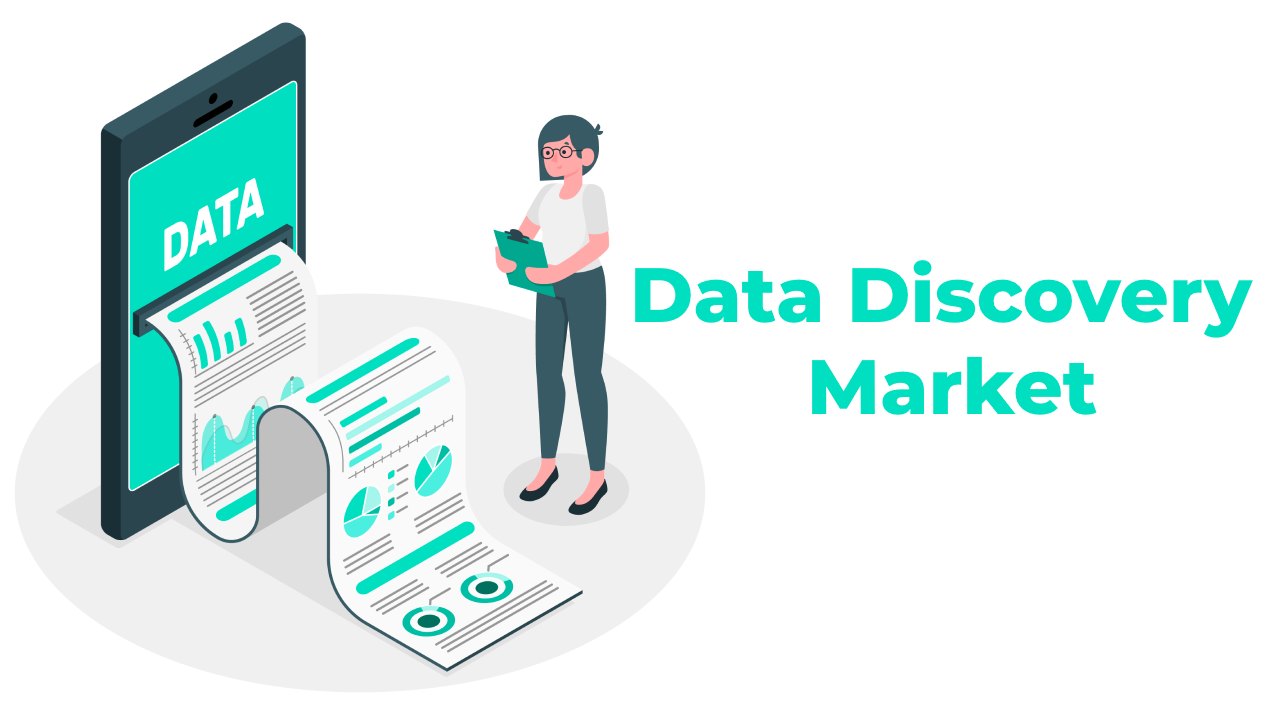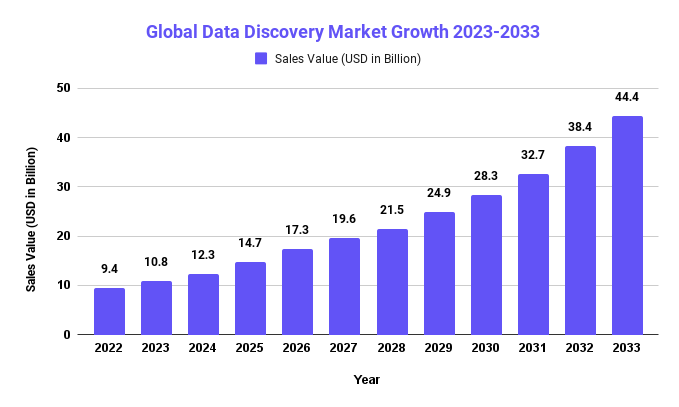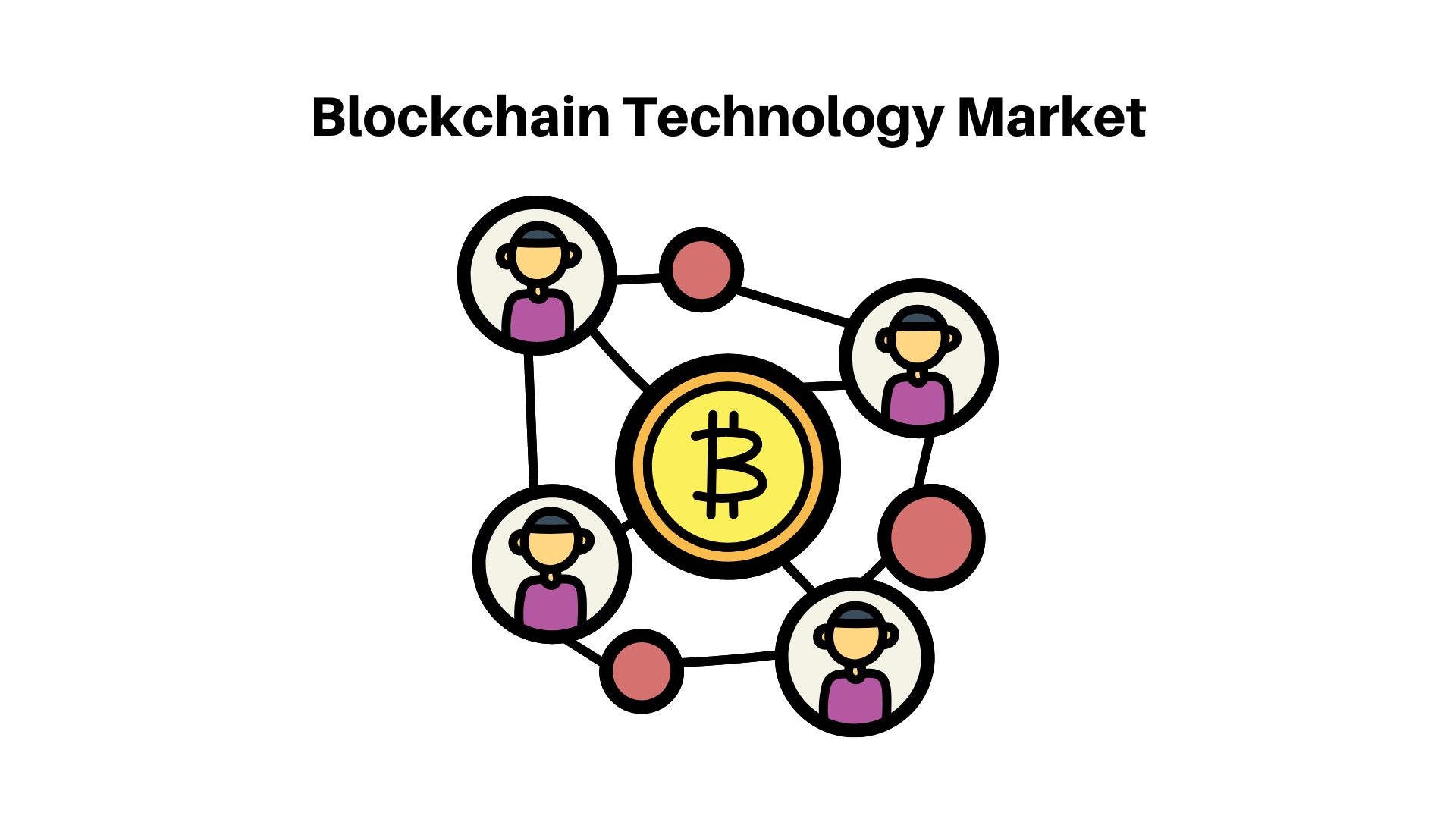Data Discovery Market Globally Expected to Drive Growth Nearly USD 44.4 Bn By 2033

Page Contents
Market Overview
Published Via 11Press : The process of exploring and identifying relevant information within a dataset or data source is known as data discovery Market. It entails analyzing and comprehending the structure, content, and relationships of the data to determine how it can be utilized to obtain insights and make informed decisions.
The Data Discovery Market size is expected to reach USD 44.4 Bn by 2033, up from its current value of USD 9.4 Bn in 2022, growing at an annual compound growth rate (CAGR) of 15.6% from 2023-2033.
The purpose of data discovery is to uncover patterns, relationships, and insights that may not be immediately apparent within the data. This process combines data analysis, data profiling, and data visualization techniques to assist users in comprehending the data and its potential value.
Typically, data discovery begins with a comprehensive analysis of the data source's format, structure, and content. This analysis may involve data profiling techniques including data quality evaluation, data provenance analysis, and metadata extraction.
The next stage in the data discovery process, after the data has been thoroughly analyzed, is to visualize the data using charts, graphs, and other visualizations. This can assist in identifying patterns and relationships within the data that may not be readily apparent.
Key Takeaways
The process of exploring and identifying relevant information within a dataset or data source is known as data discovery.
The purpose of data discovery is to uncover patterns, relationships, and insights that may not be immediately apparent within the data.
Data discovery combines data analysis, data profiling, and data visualization techniques to aid users in comprehending the data and its potential value.
Typically, data discovery begins with a comprehensive analysis of the data source's format, structure, and content.
Visualizing the data with charts, graphs, and other visualizations can aid in the identification of patterns and relationships that may not be immediately apparent.
In order to obtain a deeper understanding of the data, data discovery may involve the application of advanced analytics techniques, such as machine learning and predictive modeling.
Data discovery is an integral part of any data analysis or decision-making process, as it enables users to better comprehend and utilize the data to attain their objectives.
A combination of technical expertise, domain knowledge, and data-driven insights is required for effective data discovery.

Request Sample Copy of Data Discovery Market Report at: https://marketresearch.biz/report/data-discovery-market/request-sample/
Regional Snapshot
In North America, numerous industries, including finance, healthcare, and e-commerce, use data discovery extensively. Numerous data discovery software vendors are located in the region, and there is a high demand for data discovery specialists.
Numerous organizations have adopted data-driven decision-making practices in Europe, where data discovery is gaining popularity. Significant development in data discovery software has occurred in the region, and there is a growing demand for data discovery professionals.
Countries in Asia, such as China and India, are significantly investing in data analytics and artificial intelligence, and data discovery is becoming increasingly popular. Numerous data discovery startups are located in this region, which has also seen a significant increase in data science and analytics positions.
In Latin America, data discovery is still in its infancy, but the region is rapidly catching up. Numerous companies in Brazil have adopted data-driven practices and invested in data analytics, placing it at the forefront.
Any inquiry, Speak to our expert at: https://marketresearch.biz/report/data-discovery-market/#inquiry
Drivers
The ever-increasing amount of data generated by organizations and individuals has necessitated the need for data discovery in order to unearth insights and patterns that may be concealed within the immense quantity of data.
Organizations are increasingly employing data-driven decision making practices, which demand a comprehensive comprehension of the available data and its potential value.
Organizations are using data discovery to obtain a competitive advantage by uncovering insights that can help them optimize their operations, improve their products and services, and better understand their customers.
The rapid evolution of technology, such as artificial intelligence, machine learning, and predictive analytics, drives the need for data discovery to help organizations remain ahead of the curve.
Data discovery is also used to assist organizations in complying with regulations and managing risk by identifying potential problems and areas of concern within their data.
Customers have an ever-increasing demand for personalized experiences and customized offerings from businesses, which can only be met through a comprehensive comprehension of customer data.
The need for organizations to obtain a competitive advantage in today's data-driven economy is driving data discovery.
Restraints
The integrity of the data is a significant barrier to data discovery. Poor data quality, incomplete data, or data with absent values can make it challenging to draw accurate conclusions or discover insights from the data.
Data governance, which includes data privacy and security, may impede data discovery. Organizations must ensure compliance with regulations and protection of sensitive data while retaining the ability to analyze data.
The technical complexity of data discovery can also be a hindrance. Data discovery involves multiple stages, including data preparation, analysis, and visualization, which can be time-consuming and necessitate specialized skills and equipment.
Organizational Buy-In Lack of organizational buy-in is another barrier to data discovery. Organizations must acknowledge the importance of data-driven decision making and invest in the resources and infrastructure required to support data discovery.
The expense of data discovery software, infrastructure, and personnel can also be a hindrance for organizations, particularly small and medium-sized businesses.
Opportunities
Data discovery enables organizations to make better-informed decisions by identifying patterns, trends, and insights that may be buried within their data.
Data discovery can help organizations identify new revenue streams by revealing previously unknown insights about their customers and the market.
Data discovery can also help organizations improve the customer experience by personalizing offerings and gaining a deeper comprehension of customer preferences and needs.
Data discovery can help organizations optimize their processes by identifying inefficiencies and enhancement opportunities, resulting in cost savings and increased productivity.
Data discovery can provide a competitive advantage by enabling organizations to better understand their market and customers, identify emerging trends, and make data-driven decisions.
Data discovery can foster innovation by enabling organizations to identify new opportunities and develop new products and services based on data-derived insights.
Data discovery can assist organizations in managing risk by identifying potential problems or areas of concern within their data and taking proactive steps to mitigate them.
Data discovery provides numerous opportunities for organizations to improve their operations, make informed decisions, and obtain a competitive advantage in their respective markets by leveraging data. Organizations can actualize the full potential of data discovery by adopting data-driven practices and investing in the necessary resources and infrastructure.
Challenges
The increasing volume, variety, and velocity of data can make meaningful insights from data difficult to extract. Especially when working with unstructured or semi-structured data, this complexity can pose a significant obstacle to data discovery.
Poor data quality can be a significant challenge for data discovery. Inaccurate, insufficient, or inconsistent data can lead to erroneous conclusions and decisions, so it is crucial to ensure data quality prior to commencing the data discovery process.
Data security and privacy are major considerations in data discovery. Organizations must protect sensitive data and comply with regulations such as the GDPR and HIPAA.
Data discovery necessitates a vast array of technical abilities, such as data science, statistics, programming, and data visualization. Finding and keeping qualified people to execute data discovery may be difficult for some organizations.
Data discovery may necessitate integration with existing systems, which can be difficult when dealing with legacy systems or systems with varying data formats.
The expense of data discovery software, hardware, and personnel can be problematic for organizations, particularly small and medium-sized enterprises.
The incorporation of data-driven practices may necessitate substantial modifications to the organizational culture and procedures. Resistance to change can be a formidable obstacle to surmount.
Market Segmentation
platform
- web
- desktop
- mobile
deployment
- on-premises
- Cloud
industry vertical
- public sector
- BFSI
- telecom
- retail
- healthcare
- education
- energy
- automobile
- Others
Key Players
- Tableau Software
- Alteryx Inc.
- Logi Analytics
- TIBCO Software Inc.
- Pentaho Corporation
- QlikTech International AB
- Microsoft Corporation
- MicroStrategy Inc.
- ClearStory Data
- SAS Institute Inc.
Report Scope
| Report Attribute | Details |
| Market size value in 2022 | USD 9.4 Bn |
| Revenue forecast by 2033 | USD 44.4 Bn |
| Growth Rate | CAGR Of 15.6% |
| Regions Covered | North America, Europe, Asia Pacific, Latin America, and Middle East & Africa, and Rest of the World |
| Historical Years | 2017-2022 |
| Base Year | 2022 |
| Estimated Year | 2023 |
| Short-Term Projection Year | 2028 |
| Long-Term Projected Year | 2033 |
Request Customization Of The Report: https://marketresearch.biz/report/data-discovery-market/#request-for-customization
Recent Developments
prevalence of Cloud-Based Data Discovery Platforms: In recent years, the prevalence of cloud-based data discovery platforms has increased significantly. These platforms offer scalability, adaptability, and deployment simplicity, making them an attractive option for organizations wishing to implement data discovery.
Emergence of AI-Enabled Data Discovery Tools AI-enabled data discovery tools are gaining popularity as they provide more sophisticated data analysis capabilities. These tools utilize machine learning algorithms to automate data analysis, reduce manual labor, and generate more precise insights.
The prevalence of data discovery tools in the healthcare industry has increased significantly over the past several years. These instruments are utilized to analyze patient data, identify health trends, and enhance patient outcomes.
There is a growing emphasis on ensuring that data discovery platforms comply with regulations such as GDPR and HIPAA, in response to the growing concern over data privacy and security.
Convergence of Data Discovery and Business Intelligence: The convergence of data discovery and business intelligence is on the rise, with many organizations seeking to implement a unified data analytics strategy that employs both data discovery and business intelligence technologies.
Data discovery tools are increasingly being used to analyze consumer data and enhance the customer experience in the retail industry. These tools are utilized to determine customer preferences, customize offerings, and optimize pricing strategies.
Utilization of Data Discovery in Fraud Detection Data discovery technologies are utilized in fraud detection, particularly in the financial services industry. These tools are capable of analyzing vast quantities of data to identify patterns that may indicate fraudulent activity.
Key Questions
What exactly is data discovery?
Data discovery is the process of identifying patterns, trends, and insights within data in order to obtain a deeper understanding of the data and to inform decision-making.
What advantages does data discovery offer?
The benefits of data discovery include enhanced decision-making, new revenue streams, enhanced customer experience, process optimization, competitive advantage, innovation, and enhanced risk management.
What challenges does data discovery present?
Data discovery's challenges include data complexity, data quality, data security and privacy, technical skills, integration with existing systems, cost, and change management.
What recent advancements have been made in data discovery?
Recent data discovery developments include the increased adoption of cloud-based data discovery platforms, the emergence of AI-enabled data discovery tools, the growth of data discovery in industries such as healthcare and retail, and the convergence of data discovery and business intelligence.
What competencies are required for data discovery?
Data discovery requires a variety of skills, including data science, statistics, programming, data visualization, and business acumen. In addition, knowledge of the industry or domain being analyzed is essential.
What instruments are utilized in data discovery?
There are numerous tools used in data discovery, such as data visualization tools like Tableau and Power BI, data analysis tools like Python and R, and AI-enabled data discovery platforms like IBM Watson Discovery and Salesforce Einstein Discovery.
What is the data discovery process?
Typically, the data discovery process consists of data acquisition, data preparation, data exploration, data analysis, and data visualization. Depending on the organization's specific objectives and requirements, the procedure may vary.
Contact us
Contact Person: Mr. Lawrence John
Marketresearch.Biz (Powered By Prudour Pvt. Ltd.)
Tel: +1 (347) 796-4335
Send Email: [email protected]
Content has been published via 11press. for more details please contact at [email protected]
The team behind market.us, marketresearch.biz, market.biz and more. Our purpose is to keep our customers ahead of the game with regard to the markets. They may fluctuate up or down, but we will help you to stay ahead of the curve in these market fluctuations. Our consistent growth and ability to deliver in-depth analyses and market insight has engaged genuine market players. They have faith in us to offer the data and information they require to make balanced and decisive marketing decisions.



